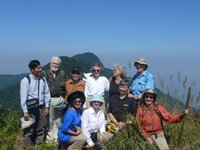Reality
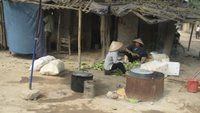 In contrast to the lovely Hoan Kiem, this is what an average day in the life of a farmer might look like. They have little time to walk the city and enjoy the scenery or notice the butterflies. They are hardworking people accustomed to doing most of the labor on their farms by hand. These farmers are cleaning corn, a newly popular crop in Vietnam. Corn and rice are rotated in the fields in an attempt to keep more nutrients in the soil.
In contrast to the lovely Hoan Kiem, this is what an average day in the life of a farmer might look like. They have little time to walk the city and enjoy the scenery or notice the butterflies. They are hardworking people accustomed to doing most of the labor on their farms by hand. These farmers are cleaning corn, a newly popular crop in Vietnam. Corn and rice are rotated in the fields in an attempt to keep more nutrients in the soil.
Strolling at Hoan Kiem
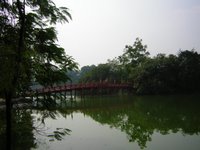 Hanoi has its own beauty. Before I came here I read as much as I could about the culture and about the place, but reading is nothing like seeing it firsthand.
Hanoi has its own beauty. Before I came here I read as much as I could about the culture and about the place, but reading is nothing like seeing it firsthand.
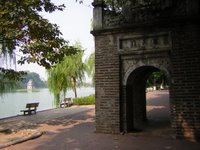 Every city seems to try and create an area of beauty for its residents and tourists and Hanoi is no different. Huc Bridge, the circular walk and the temple on the lake were all made as a place to find peace.
Every city seems to try and create an area of beauty for its residents and tourists and Hanoi is no different. Huc Bridge, the circular walk and the temple on the lake were all made as a place to find peace.
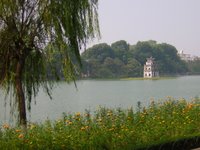 I can't seem to get enough of walking around Hoan Kiem Lake. Right in the center of a frantic, bustling city, this serene place reminds me that people everywhere are no different - we all want some place to go to escape the hustle and bustle of life.
I can't seem to get enough of walking around Hoan Kiem Lake. Right in the center of a frantic, bustling city, this serene place reminds me that people everywhere are no different - we all want some place to go to escape the hustle and bustle of life.
The weather could not have been better - and I should remember this if I ever want to visit again - November is the dry season when the sun shines in Hanoi. Studying butterflies in Vietnam has been a great experience. I have learned a lot about them and about this country. The world is full of interesting things to study and wonderful places to study them. So where to go next? It's always so hard to decide!
Ha Long - So Long
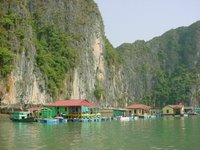 I made myself take a tour of Ha Long Bay, a famous World Heritage site - a bay filled with over 3000 islands. I was actually surprised by 2 things here; the first, and I couldn't get over this, was the butterflies! How does a butterfly survive on the water here - maybe on the boats, I am not sure, but there were so many butterflies flying over the water.
I made myself take a tour of Ha Long Bay, a famous World Heritage site - a bay filled with over 3000 islands. I was actually surprised by 2 things here; the first, and I couldn't get over this, was the butterflies! How does a butterfly survive on the water here - maybe on the boats, I am not sure, but there were so many butterflies flying over the water.
The other thing was the floating village on the water. This is a traditional village built of houses that float on what look like tubs or kegs. The people in this village have lived here for hundreds of years and continue to live here, partly tradition, partly not knowing another way of life. This photo is of the school and a couple of houses. We stopped at one to purchase some seafood - of course it was alive and in caged areas, then the local people here prepared it. Notice, they even have television antennae (you have to look closely). This is a close-up of one of the houses.
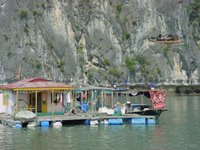 Imagine living in a village with only water, no grass to run around on. The children here do not go to school outside the area until they reach the third grade! No soccer - no frisby golf - nothing on land, not even a lawn - until age 9. Just imagine it!
Imagine living in a village with only water, no grass to run around on. The children here do not go to school outside the area until they reach the third grade! No soccer - no frisby golf - nothing on land, not even a lawn - until age 9. Just imagine it!
Visiting Ha Long Bay from Hanoi takes all day. It is about a 3 hour drive, then you have to take the boat out on the bay. We also visited the caves inside the large stone areas. I am glad I went, it gave me another new appreciation of some of the Vietnamese cultures that live within this amazing country.
Traditional Stories & Folk Tales
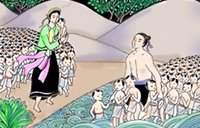 Much of Vietnamese culture is made up of folk tales - old stories about the origination of things. Even the songs of Vietnam come from the old stories - and people here have a special emotional connection to them. There is a story in Vietnam for everything; such as the legend of Hoan Kiem Lake (a magic turtle gives the king a sword to conquer his northern enemies). I find the stories entertaining, and after talking with a number of locals in Hanoi I have discovered that they tell them mostly for entertainment value - they don't really believe that the stories were true. I visited a temple that is called the "ladies' temple" because it was founded on one of these stories, "100 Eggs, 100 Children."
Much of Vietnamese culture is made up of folk tales - old stories about the origination of things. Even the songs of Vietnam come from the old stories - and people here have a special emotional connection to them. There is a story in Vietnam for everything; such as the legend of Hoan Kiem Lake (a magic turtle gives the king a sword to conquer his northern enemies). I find the stories entertaining, and after talking with a number of locals in Hanoi I have discovered that they tell them mostly for entertainment value - they don't really believe that the stories were true. I visited a temple that is called the "ladies' temple" because it was founded on one of these stories, "100 Eggs, 100 Children."
So I can't help wonder, did anyone ever believe them? If so, it would sort of be like us believing that the "Three Little Pigs" story really happened. But then, maybe that is taking things a little too far. You decide.
If you want to read some of the folk tales you might want to visit a website called "Kid's Corner." It has a lot of stories that you can read through quickly and get a sense of how the people view tragedy and happy endings. Make sure you click on the English version.
Artwork and stories from 1996-98, Kicon, Inc.
Hanoi - Average Day in Motion
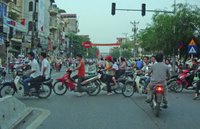 Traffic in Hanoi is definitely something worth seeing. What seems entertaining to me is a way of life to everyone else. Motorbikes line every street and are intermingled with bicycles and SUVs . Traffic lights exist but merely as a suggestion. To walk across one of these busy streets you just sort of start walking - and don't look! If you look you are likely to walk too fast and cause an accident. I crossed several streets in my daily travels, and this is the only way to go. Slow and steady walking make it easy for motorbikes to go around you. No one drives faster than 25 or 30 miles per hour, most are slower, even on the double highway (something we might call the freeway). I loved it, especially how comfortable everyone is - and how patient. I think I said it before - this is the most patient society I have ever seen - we could learn something. If you want to see a video of daily traffic, click the photo - it is about a minute long, but it is amazing. No sound, just video.
Traffic in Hanoi is definitely something worth seeing. What seems entertaining to me is a way of life to everyone else. Motorbikes line every street and are intermingled with bicycles and SUVs . Traffic lights exist but merely as a suggestion. To walk across one of these busy streets you just sort of start walking - and don't look! If you look you are likely to walk too fast and cause an accident. I crossed several streets in my daily travels, and this is the only way to go. Slow and steady walking make it easy for motorbikes to go around you. No one drives faster than 25 or 30 miles per hour, most are slower, even on the double highway (something we might call the freeway). I loved it, especially how comfortable everyone is - and how patient. I think I said it before - this is the most patient society I have ever seen - we could learn something. If you want to see a video of daily traffic, click the photo - it is about a minute long, but it is amazing. No sound, just video.
Citizen science
Educating the general population about conservation is a long and difficult process in countries like Vietnam. Programs like those started by Smithsonian Institute are effective in the United States - and many people express an interest. But in Vietnam, where the main concern has been survival, conservation has had few supporters.
If you would like to try a butterfly project, visit the Smithsonian Butterfly Watch website - or start a project of your own. By trying this you will get a better sense of what it takes to research butterflies - and educate yourself about conservation.
Water Puppet Show, Hanoi
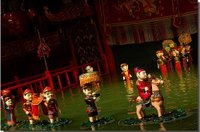 When we reach Hanoi we are taken to the Hanoi Water Puppet Show. Lien has purchased tickets for all of us in advance. The Water Puppet Show is a unique experience. I have never seen another performance like it.
When we reach Hanoi we are taken to the Hanoi Water Puppet Show. Lien has purchased tickets for all of us in advance. The Water Puppet Show is a unique experience. I have never seen another performance like it.
Invented during the Ly Dynasty (1009-1225), the water puppet show is unique to Vietnam. Rice fields during growing season are submerged in water. At some point someone had the idea that the pools of water on the fields would be a great place for a show. The ponds and lakes of the northern plains, where crowds gathered during festivals, become the lively stages for the water puppet shows. Puppets are made of wood and coated with waterproof paint. Each puppet is handmade, has its own posture, and expresses a certain character.
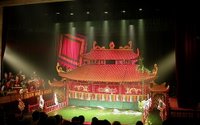 The stage is beautiful. It stands in a small pool of water to represent the fields where it was born. Everything is handled with bamboo sticks beneath the water. Singers sit on the side and do all the spoken parts while traditional Vietnamese music plays. Performers hide behind the main curtain and manipulate the puppets, then come out for a bow at the end
The stage is beautiful. It stands in a small pool of water to represent the fields where it was born. Everything is handled with bamboo sticks beneath the water. Singers sit on the side and do all the spoken parts while traditional Vietnamese music plays. Performers hide behind the main curtain and manipulate the puppets, then come out for a bow at the end
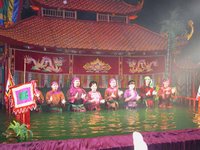 Today the Puppet show is a reflection of the past. It shows stories of farmers, of religion and of folk stories. Music in the show is played and sung by a live traditional Vietnamese orchestra. Everything is in Vietnamese, but it is still wonderful.
Today the Puppet show is a reflection of the past. It shows stories of farmers, of religion and of folk stories. Music in the show is played and sung by a live traditional Vietnamese orchestra. Everything is in Vietnamese, but it is still wonderful.
Market Day
 We are heading back toward Hanoi. Many people in our group want to stop and get some things; we have run out of supplies, some people in our party have souvenirs to purchase, we all want to get some coffee.
We are heading back toward Hanoi. Many people in our group want to stop and get some things; we have run out of supplies, some people in our party have souvenirs to purchase, we all want to get some coffee.
The market is very crowded. It is difficult to walk in the crowd without breathing in someone's ear. I notice at one point that someone has grabbed me around the middle - a woman in the market. Apparently she wants to see just how affluent I am; my midsection is squeezed a bit - then let go. I suppose she has found out what she wanted to know. I am not insulted or even bothered. I know the culture is curious about foreigners, I can't blame them.
Sunrise, Sunset
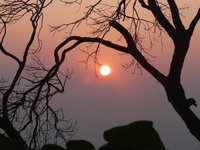 Did you ever notice how much lovelier the sunrise and sunset are in a place you are visiting? It seems our surroundings want to wish us 'good travels' and so offer us the best view of the skies. We couldn't ask for things to be lovelier this last day.
Did you ever notice how much lovelier the sunrise and sunset are in a place you are visiting? It seems our surroundings want to wish us 'good travels' and so offer us the best view of the skies. We couldn't ask for things to be lovelier this last day.
And so we must say goodbye to the butterflies, to Tam Dao and to our friends here at the MiMi Hotel. This is a simple reminder of how lovely our time here has been.
Final Meeting
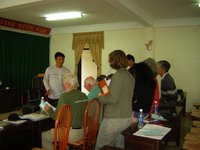 In our final official meeting with Lien was spent reviewing all the data. This is when he presented us with the conclusions and summaries of all we collected and observed.
In our final official meeting with Lien was spent reviewing all the data. This is when he presented us with the conclusions and summaries of all we collected and observed.
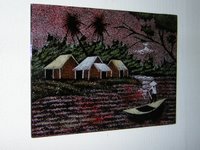 Afterward he gave us each a gift - which was a huge surprise to all of us. One of the traditional forms of art here is called lacquer painting. I had seen it before but didn't really know what it was. It is a specialized art form of painting made from the sap of the lacquer tree.
Afterward he gave us each a gift - which was a huge surprise to all of us. One of the traditional forms of art here is called lacquer painting. I had seen it before but didn't really know what it was. It is a specialized art form of painting made from the sap of the lacquer tree.
The painting is done on wood. It is covered with a piece of cloth glued to it using the sap of the lacquer tree and then coated with a layer of the sap mixed with earth. The board is then sand papered and recoated with a layer of hot sap. After polishing, the smooth black surface shines with a brilliant luster.
This picture does not do justice to how lovely the picture really is - but hopefully you can get the idea. What you may not be able to see is that there is an inscription on the painting in the lower left hand corner - is says "Butterflies of Vietnam 2006." What a lovely gift.
Celebration
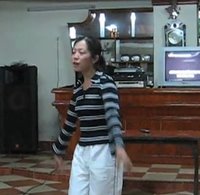 (click each picture to see the movie and hear the song). To learn more about traditional Vietnamese music visit the Be Hat Dan Ca Website.
(click each picture to see the movie and hear the song). To learn more about traditional Vietnamese music visit the Be Hat Dan Ca Website.
Our final evening at the MiMi Hotel was a huge celebration. The cooks made a feast then joined us for green tea and songs. Vietnamese people love music - folk music, traditional, rock-and-roll, Karaoke and American pop.
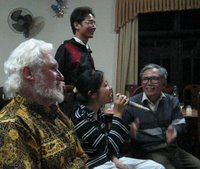 As we gathered after our meal to sing and listen, we were honored to have our hosts join us and share their music. They wanted us to share some, too, but since our culture is so mixed up, it was difficult for us to think of any folk or traditional songs that we all knew. Two people in our group are from the UK - we just didn't know all the same songs. But we tried. Pathetically.
As we gathered after our meal to sing and listen, we were honored to have our hosts join us and share their music. They wanted us to share some, too, but since our culture is so mixed up, it was difficult for us to think of any folk or traditional songs that we all knew. Two people in our group are from the UK - we just didn't know all the same songs. But we tried. Pathetically.
The first song here is a traditional Vietnamese folk song, "Trống cơm," a tragic story of a boy and the "rice drum.' The second is an American pop song, "Seasons in the Sun" and it sounds so lovely in Vietnamese. If you want to see the words and hear the tune, click the song title. (a poor copy of the song with words can be heard here). Viet joins in for the final lines in English. Viet often uses American songs to teach English to his classes, so he knows the words to a lot of American style music. Do you recognize this song?
Indicator Species Tally
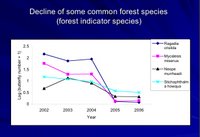 This is a summary of the species used as forest indicators.
This is a summary of the species used as forest indicators.
You can see from this summary that the species used to monitor forest health has declined signficantly over the last four years.
This is primarily do to forest destruction, not only from general population and uncontrolled logging, but also to road construction. Indicator species are more sensitive to forest health, which is why they are being monitored. There are four listed.
Transects
In case you were wondering what all the transects were where we monitored the species, they are as follow:
--Transects 1, 2 and 3 are all along the new road. This is a very long new road and it leads up to the mountain, where we climbed to the top.
--Transect 4 (TR4) is the old road, very close to the edge of town. This runs all the way back to the chayote field.
--Transect 5 (TR5) is the road to the TV tower where we climbed all the steps.
--Transect 6 (TR6) is the bamboo forest. This is where the least species is always observed, because butterflies like open areas.
Summarizing the Research
 I have to admit, while we were out each day it is difficult to get a sense of the "bigger picture" concerning all the data involved. It is sometimes a little boring looking for, say, caterpillars. You just have to walk around turning over leaves until you see something, then when you do, you have to write it on the data sheet.
I have to admit, while we were out each day it is difficult to get a sense of the "bigger picture" concerning all the data involved. It is sometimes a little boring looking for, say, caterpillars. You just have to walk around turning over leaves until you see something, then when you do, you have to write it on the data sheet.
 But now that all our information has been compiled it looks impressive and it means something. According to the data collected from this session, compared to previous ones, you can see that the number of overall species observed is higher as compared to this time last year.
But now that all our information has been compiled it looks impressive and it means something. According to the data collected from this session, compared to previous ones, you can see that the number of overall species observed is higher as compared to this time last year.
These numbers reflect total individuals (not species) sighted in each transect. This chart demonstrates how the numbers are compiled in a spreadsheet.
New Discovery
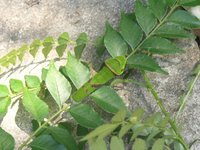 According to Lien's research, we identified a new Papilio caterpillar on Zanthoxylum avicennia (Rutaceae) for the first time. This long name is the name of a native plant in the Tam Dao area and in many other Indochina regions. He blends in very well with the foliage, don't you think?
According to Lien's research, we identified a new Papilio caterpillar on Zanthoxylum avicennia (Rutaceae) for the first time. This long name is the name of a native plant in the Tam Dao area and in many other Indochina regions. He blends in very well with the foliage, don't you think?
Indicator Species
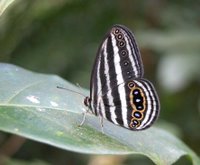 The first photo here is one of the species that are sensitive to the forest health, and are not considered common to other areas of Vietnam. Its name is Ragadia Crisilda, the common name is Striped Ringlet. Notice how its colors and spots are prominent. The spots can be used as camouflage as the spots resemble eyes of other large insect or even small mammals.
The first photo here is one of the species that are sensitive to the forest health, and are not considered common to other areas of Vietnam. Its name is Ragadia Crisilda, the common name is Striped Ringlet. Notice how its colors and spots are prominent. The spots can be used as camouflage as the spots resemble eyes of other large insect or even small mammals.
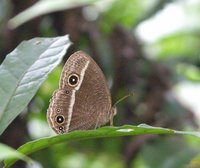 The second photo is Neope Muirheadi. We have had a lot of success during the observation time of the project. We have observed a total of 83 species - actually more than this time last year.
The second photo is Neope Muirheadi. We have had a lot of success during the observation time of the project. We have observed a total of 83 species - actually more than this time last year.
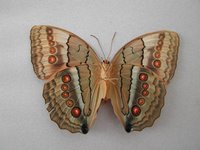 The third photo pictured is Stichophthalm howqua, another indicator species.
The third photo pictured is Stichophthalm howqua, another indicator species.
Dr. Vu (Lien) presented his material for publication in the Biodiversity and Conservation journal - in it he describes the research and the transects involved in data collection. Two years have passed since this publication and much more data has been collected to support the theories Dr. Vu proposed in the project. You may view photos of Lien's butterflies on his website.
The four species specific as indicators for this study are
1. Ragadia crisilda (pictured)
2. Neope muirheadi (pictured)
3. Stichophthalm howqua (pictured)
4. Mycalesis misensus (NOT pictured)
Dong
 The monetary exchange confused me at first but I find that after a while I have gotten the hang of it. If I memorize that 50,000 dong (pronounced dohm) is approximately $6, I can get around town with little difficulty.
The monetary exchange confused me at first but I find that after a while I have gotten the hang of it. If I memorize that 50,000 dong (pronounced dohm) is approximately $6, I can get around town with little difficulty.
One US dollar is equivalent to 16,000 dong - pictured here. The easiest way to figure out how much something costs is to use a calculator - and multiply any US dollar amount by the number 16,000; that is close enough to the daily exchange rate, and they way most every vendor does it. My supper one day came to 135,000 - so how much do you think I spent? (divide that number by 16,000). A tour I took of the city cost me over a million dong! exactly 1,120,000 - what a shock that was, since I wasn't yet comfortable with the conversion. How much was my tour?
All the money has a picture of Ho Chi Minh, the beloved (and now deceased) leader of the country, who really was a pretty amazing person. Most citizens refer to him as "Uncle Ho," giving him an honored place in their memory as a revered ancestor.
 50,000 dong is $3, an acceptable amount for a tip - or for a day's worth of Internet at the computer shack.
50,000 dong is $3, an acceptable amount for a tip - or for a day's worth of Internet at the computer shack.
In ter net
 Vietnamese is a monosyllabic language - that means that every word they use only has one syllable - unlike ours. So when they say the word Internet - they say it as three words, each one with its own meaning.
Vietnamese is a monosyllabic language - that means that every word they use only has one syllable - unlike ours. So when they say the word Internet - they say it as three words, each one with its own meaning.
This is the outside of the Internet shack where I spend so much of my time getting stuff online for you to view and read. The room where the computers are located is way in the back of this photo, behind the first building. There are 15 computers crammed into this one little room, and they each share the same dialup connection.
Internet gaming is popular, as I said in an earlier post. Empire is the most common game, but if I get to the computers before the end of the school day, or after supper it isn't so crowded. We have stayed quite late, and are often the last to leave, especially if we get there when students are there, making things much slower. It costs me an average of about $3 a day - if I stay 4 hours. Not too bad, and at least I can get stuff online. I do like staying connected....
 In contrast to the lovely Hoan Kiem, this is what an average day in the life of a farmer might look like. They have little time to walk the city and enjoy the scenery or notice the butterflies. They are hardworking people accustomed to doing most of the labor on their farms by hand. These farmers are cleaning corn, a newly popular crop in Vietnam. Corn and rice are rotated in the fields in an attempt to keep more nutrients in the soil.
In contrast to the lovely Hoan Kiem, this is what an average day in the life of a farmer might look like. They have little time to walk the city and enjoy the scenery or notice the butterflies. They are hardworking people accustomed to doing most of the labor on their farms by hand. These farmers are cleaning corn, a newly popular crop in Vietnam. Corn and rice are rotated in the fields in an attempt to keep more nutrients in the soil.

























